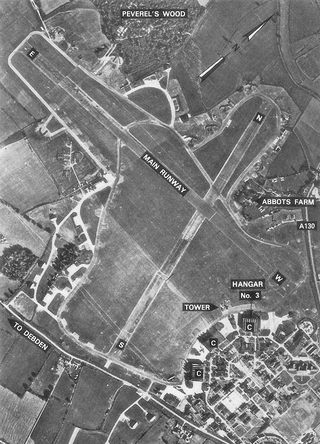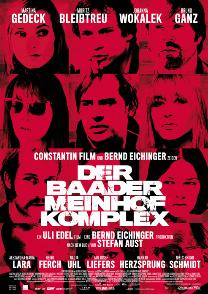
The Red Army Faction, also known as the Baader–Meinhof Group or Baader–Meinhof Gang, was a West German far-left militant group founded in 1970 and active until 1998. The RAF described itself as a communist and anti-imperialist urban guerrilla group. It was engaged in armed resistance against what it considered a fascist state. Members of the RAF generally used the Marxist–Leninist term faction when they wrote in English. Early leadership included Andreas Baader, Ulrike Meinhof, Gudrun Ensslin, and Horst Mahler. The West German government considered the RAF a terrorist organization.

The 2 June Movement was a West German anarchist militant group based in West Berlin. Active from January 1972 to 1980, the anarchist group was one of the few militant groups at the time in Germany. Although the 2 June Movement did not share the same ideology as the Red Army Faction, these organizations were allies. The 2 June Movement did not establish as much influence in Germany as their Marxist counterparts, and is best known for kidnapping West Berlin mayoral candidate Peter Lorenz.

HMS Egret was a sloop of the British Royal Navy, the lead ship of her class. She was built by J. Samuel White at Cowes, Isle of Wight, was launched on 31 May 1938, and entered service on 11 November that year. Egret served as a convoy escort with the Western Approaches Command from 1940 until her loss in August 1943: She was on anti-submarine patrol in the Bay of Biscay when she was sunk by a guided missile in combat, the first ship to be lost in this manner.

The Allied bombing of Hamburg during World War II included numerous attacks on civilians and civic infrastructure. As a large city and industrial centre, Hamburg's shipyards, U-boat pens, and the Hamburg-Harburg area oil refineries were attacked throughout the war.

RAF Bomber Command controlled the Royal Air Force's bomber forces from 1936 to 1968. Along with the United States Army Air Forces, it played the central role in the strategic bombing of Germany in World War II. From 1942 onward, the British bombing campaign against Germany became less restrictive and increasingly targeted industrial sites and the civilian manpower base essential for German war production. In total 364,514 operational sorties were flown, 1,030,500 tons of bombs were dropped and 8,325 aircraft lost in action. Bomber Command crews also suffered a high casualty rate: 55,573 were killed out of a total of 125,000 aircrew, a 44.4% death rate. A further 8,403 men were wounded in action, and 9,838 became prisoners of war.

Number 617 Squadron is a Royal Air Force aircraft squadron, originally based at RAF Scampton in Lincolnshire and currently based at RAF Marham in Norfolk. It is commonly known as "The Dambusters", for its actions during Operation Chastise against German dams during the Second World War. In the early 21st century it operated the Panavia Tornado GR4 in the ground attack and reconnaissance role until being disbanded on 28 March 2014. The Dambusters reformed on 18 April 2018, and was equipped at RAF Marham in June 2018 with the Lockheed Martin F-35B Lightning, becoming the first squadron to be based in the UK with this advanced V/STOL type. The unit is composed of both RAF and Royal Navy personnel, and operates from the Royal Navy's Queen Elizabeth-class aircraft carriers.

Royal Air Force Debden or more simply RAF Debden is a former Royal Air Force station located 3 miles (4.8 km) southeast of Saffron Walden and approximately 1 mile (1.6 km) north of the village of Debden in north Essex, England

The Area Bombing Directive was a directive from the wartime British Government's Air Ministry to the Royal Air Force, which ordered RAF Bomber Command to destroy Germany's industrial workforce and the morale of the German population, through bombing German cities and their civilian inhabitants.
Ingrid Schubert was a West German militant and founding member of the Red Army Faction (RAF). She participated in the freeing of Andreas Baader from prison in May 1970 as well as several bank robberies before her arrest in October 1970. She was found dead in her cell in 1977.
Birgit Hogefeld is a former member of the West German Red Army Faction (RAF).

The bombing of Königsberg was a series of attacks made on the city of Königsberg in East Prussia during World War II. The Soviet Air Force had made several raids on the city since 1941. Extensive attacks carried out by RAF Bomber Command destroyed most of the city's historic quarters in the summer of 1944. Königsberg was also heavily bombed during the Battle of Königsberg, in the final weeks of the war.
The German city of Mannheim in the state of Baden-Württemberg saw bombing during World War II from December 1940 until the end of the war. Mannheim saw over 150 air raids.
Gabriele Kröcher-Tiedemann (1951–1995) was a German far-left militant, associated with the Movement 2 June (J2M) and the Red Army Faction. She married Norbert Kröcher in 1971 and later divorced him whilst she served a prison sentence. She was freed by the kidnapping of Peter Lorenz in 1975, then participated in the OPEC siege. In 1977, she was arrested in Switzerland after shooting two policemen. She was imprisoned until 1991 and died in 1995.

The Lost Honour of Katharina Blum, or: How violence develops and where it can lead is a 1975 German political drama film, based on the 1974 novel of the same name by Heinrich Böll, written for the screen and directed by Volker Schlöndorff and Margarethe von Trotta. Schlöndorff and von Trotta wrote the script with an emphasis on the vindictive and harsh treatment of an innocent woman by the public, the police and the media. The film stars Angela Winkler as Blum, Mario Adorf as Kommissar Beizmenne, Dieter Laser as Tötges, and Jürgen Prochnow as Ludwig. The film and the novel were also adapted into an American TV film titled The Lost Honor of Kathryn Beck in 1984.

Air Marshal Sir Harold Brownlow Morgan "Micky" Martin, was an Australian bomber pilot and senior commander in the Royal Air Force (RAF). He took part in Operation Chastise, the RAF's "Dambusters" raid in 1943, and was described by journalist Sir Max Hastings as "one of the three great bomber pilots of the war". He rose to become a senior officer in the RAF, commanding RAF Germany and later serving as Air Member for Personnel, a member of the Air Council, the RAF's controlling body.

The Baader Meinhof Complex is a 2008 German drama film directed by Uli Edel. Written and produced by Bernd Eichinger, it stars Moritz Bleibtreu, Martina Gedeck, and Johanna Wokalek. The film is based on the 1985 German best selling non-fiction book of the same name by Stefan Aust. It retells the story of the early years of the West German far-left terrorist organisation the Rote Armee Fraktion from 1967 to 1977.
Number 58 Squadron was a squadron of the Royal Air Force.
Ernst-Volker Staub is a German fugitive associated with the third generation Red Army Faction (RAF). Arrested in 1984, Staub was convicted of membership in a terrorist organization in 1986 and sentenced to 4 years in prison. Following his release in 1990, Staub went into hiding. He is wanted by the German police on suspicion of having rejoined the RAF and having been involved in further RAF activities since then.

On 13 February 1991, three members of the Red Army Faction (RAF) fired about 250 rounds using a military rifle at the United States embassy in Bonn, Germany.

The Weiterstadt prison bombing occurred on 27 March 1993, when the Red Army Faction (RAF) Command Katharina Hammerschmidt bombed and destroyed a newly built prison in Weiterstadt, near Frankfurt am Main in Germany. It was the RAF's "last anticapitalist attack" before it dissolved. Nobody was harmed in the explosion of the empty prison. Estimates of damage varied widely. Perpetrators were linked 14 years later through DNA evidence in skimasks left behind. In February 2024 Daniela Klette, one of the 4 perpetrators was arrested.














